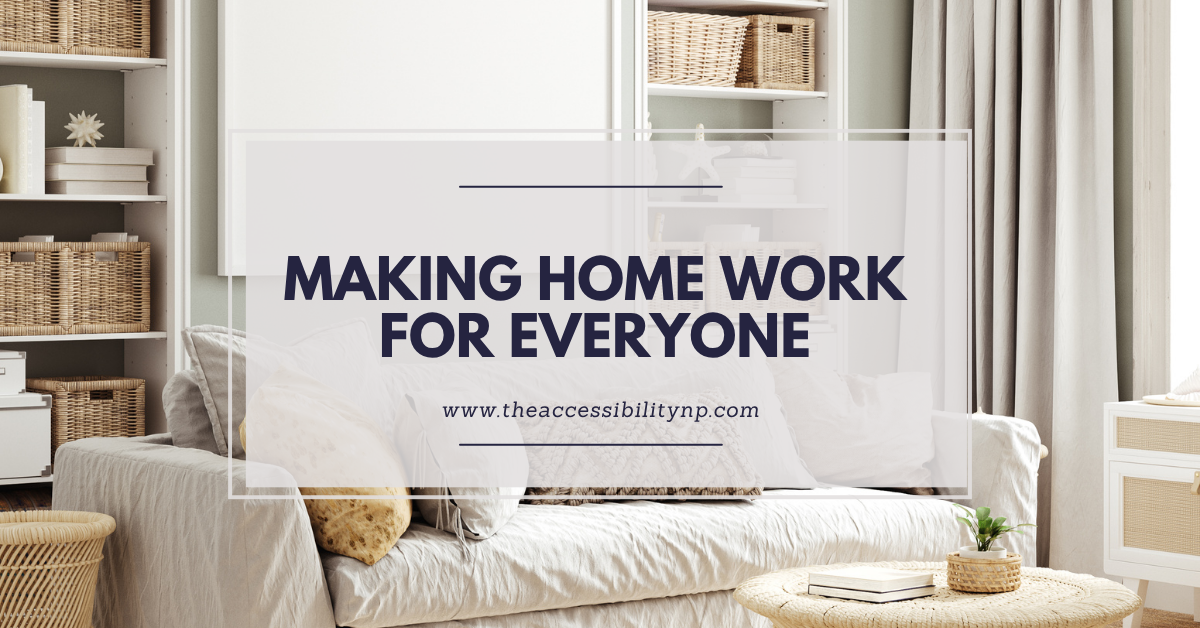Simple Modifications That Make a Big Difference
Home is where we should feel safest, most comfortable, and fully ourselves. But for many disabled individuals, everyday routines—getting out of bed, brushing teeth, preparing a meal, or taking a shower—can be filled with barriers if the environment isn’t designed with access in mind. The good news? Accessibility doesn’t have to mean a full renovation or a five-figure budget. Thoughtful modifications, both big and small, can transform daily living into something more manageable, more independent, and more dignified.
Whether you’re looking to make changes for yourself, a family member, or clients you serve, this guide will walk you through accessible home modifications tailored to everyday routines. Let’s reimagine home life—where access meets comfort, and routines feel just right.
Waking Up and Getting Out of Bed
The way we start our day sets the tone. But getting out of bed can be one of the first major barriers for many disabled individuals.
Bed height and frame:
A bed that’s too low or too high can make transfers difficult. Adjustable bed frames, especially electric ones, can help. Some models allow the head or foot of the bed to elevate, making it easier to transition from laying down to sitting upright.
Grab bars and bedside poles:
A floor-to-ceiling tension pole or wall-mounted grab bar near the bed can provide necessary support for repositioning or standing. These aids are especially useful for individuals with balance concerns, fatigue, or mobility limitations.
Lighting modifications:
Touch lamps or smart bulbs with voice control reduce the need to reach for switches. Motion-sensor night lights can guide safe navigation during nighttime bathroom trips.
Toileting and Personal Hygiene
Bathrooms are one of the most dangerous places in the home due to slips, hard surfaces, and lack of space. They’re also one of the most essential for independent living.
Grab bars and rails:
Install grab bars near the toilet and inside the shower or tub. These offer steady support for transfers and help prevent falls. Make sure they’re mounted securely and rated for weight support.
Raised toilet seats or bidets:
Raised seats can reduce the distance one needs to bend or transfer. Bidet toilet seats—many of which include warm water, air drying, and remote controls—can support hygiene for those with limited dexterity or sensory needs.
Accessible sinks and vanities:
Wall-mounted sinks provide wheelchair users better access underneath. Lever-handled or touchless faucets are easier to operate than knobs.
Shower chairs and roll-in showers:
If a full renovation isn’t feasible, start with a sturdy, slip-resistant shower chair or transfer bench. A handheld showerhead adds flexibility and ease for seated bathing.
Dressing for the Day
Getting dressed may seem simple, but it involves fine motor coordination, balance, flexibility, and planning. With the right setup and adaptive tools, this routine can feel less stressful.
Closet and drawer access:
Lower hanging rods and adjustable shelving make closets more usable. Consider open shelving or pull-out baskets to reduce the need to grip or reach. Label drawers with visuals or large print for those with cognitive or visual disabilities.
Adaptive clothing and tools:
Magnetic closures, Velcro fasteners, elastic waistbands, and side-opening garments can eliminate the barriers of buttons, zippers, and tight fits. Reachers, button hooks, and long-handled shoehorns also support independence in dressing.
Seating for dressing routines:
A stable bench or chair with armrests in the bedroom or bathroom can provide a safe place to dress while seated.
Meal Preparation and Kitchen Access
The kitchen is often the heart of the home—but without accessible design, it can become one of the hardest rooms to navigate. Fortunately, there are creative ways to build access into even the smallest kitchen.
Countertop and appliance access:
Lowered or variable-height counters and accessible stoves or cooktops with front controls are ideal. In homes where renovation isn’t possible, create a dedicated food prep zone on a lower table or rolling cart.
Accessible kitchen tools:
Look for utensils with large, non-slip grips, automatic can openers, one-handed cutting boards, and adaptive measuring cups. These tools reduce the strain of repetitive tasks and make cooking more inclusive.
Pantry and cabinet solutions:
Pull-down shelving, lazy Susans, and slide-out drawers reduce the need to reach or bend. Clear containers with tactile labels can help individuals with low vision or executive functioning difficulties.
Seating and rest breaks:
Incorporate a high stool or rolling kitchen chair for those who need to rest while cooking or prepping meals. Make sure flooring is slip-resistant and clutter is minimized for safety.
Eating and Hydration
Eating should be enjoyable and not stressful. Let’s talk about ways to reduce barriers at the table.
Adaptive dinnerware:
Plate guards, divided plates, weighted utensils, and cups with lids or straws can support safe, independent eating. These modifications are especially helpful for individuals with tremors, muscle weakness, or coordination barriers.
Hydration reminders:
Set up visual or auditory reminders to drink fluids throughout the day. Use spill-proof water bottles or hydration stations in multiple rooms to encourage access.
Seating adjustments:
Make sure chairs provide the right support, especially for children and adults who need postural stability. Footrests, cushions, or adaptive chairs like the Rifton or Tripp Trapp can make a world of difference.
Learning, Working, and Communication
Whether it’s remote learning, working from home, or supporting communication needs, your environment should promote success.
Height-adjustable desks and work surfaces:
These support both standing and seated use, especially for wheelchair users or individuals who benefit from changing positions. Lap desks and bed trays offer flexibility for those who work from non-traditional spaces.
Assistive technology integration:
Voice-controlled devices (like smart speakers), AAC devices, alternative mice/keyboards, and screen readers help bridge the access gap. Set up charging stations in easily reachable locations.
Noise and sensory considerations:
Soundproofing, noise-canceling headphones, and visual timers can improve focus and reduce overstimulation for neurodivergent individuals. Light filters or blackout curtains can also support sensory regulation.
Visual supports and routines:
Use picture schedules, dry erase boards, or talking time devices to support transitions and routines throughout the day. These tools are essential for individuals who thrive on predictability or use visual cues to communicate.
Relaxation and Entertainment
Rest and joy matter just as much as daily tasks. Creating accessible leisure spaces is just as important.
Accessible seating:
Look for sofas and chairs with firm cushions, armrests, and upright support. Recliners or adjustable lounge chairs can reduce pressure and allow for easier transfers.
Remote and device access:
Use large-button remotes, voice assistants, or switch-adapted controls for TVs, lighting, and music. For individuals with limited mobility, mount devices within reach or use mounts on wheelchairs or beds.
Outdoor access:
Ramps, threshold extenders, and smooth pathways make patios, porches, and gardens more accessible. Add shade umbrellas or quiet corners for sensory regulation. Outdoor swings, hammocks, or sensory tents can provide calming options for kids and adults alike.
Laundry and Cleaning Tasks
Household chores can promote independence—but only if access is built in.
Front-loading washers/dryers:
These are more accessible than top-loading models, especially when placed on pedestals or with a pull-out shelf underneath. Use color-coded baskets or hampers with wheels for sorting.
Cleaning tools with long handles:
Look for lightweight vacuums, robotic cleaners, and mops with adjustable handles. Adaptive tools with easy grips or one-handed operation make cleaning less overwhelming.
Checklists and visuals:
Step-by-step laminated guides or visual supports can help break down routines like laundry or dishwashing, supporting memory and independence.
Safety and Emergency Planning
Access includes preparing for the unexpected.
Doorway widening and thresholds:
If wheelchairs or walkers are in use, make sure doorways are wide enough (typically 32″ or more) and thresholds are beveled for smooth rolling access.
Smart home safety systems:
Video doorbells, emergency call buttons, and automatic door locks can be controlled through phones or voice assistants. Some systems allow caregivers to monitor safety remotely.
Emergency plans:
Keep emergency contact lists, medication info, and go-bags readily accessible. Use visual stories or social narratives to help children and adults understand emergency drills or procedures.
Final Thoughts — Little Changes, Big Impact
Accessibility doesn’t always require a full remodel. It’s about thoughtful changes—meeting people where they are, in the spaces where they live and grow. When we focus on access in everyday routines, we’re not just improving function; we’re affirming dignity, autonomy, and belonging.
Creating an accessible home is an ongoing process. It changes with age, ability, and circumstance. But the foundation stays the same—respecting the individual’s needs and supporting them with intentional, inclusive design.
Whether you’re making one change this month or planning a full accessibility overhaul, know that every modification—every grab bar, voice command, or adaptive spoon—is a step toward independence, safety, and inclusion. And that’s always worth the investment.

